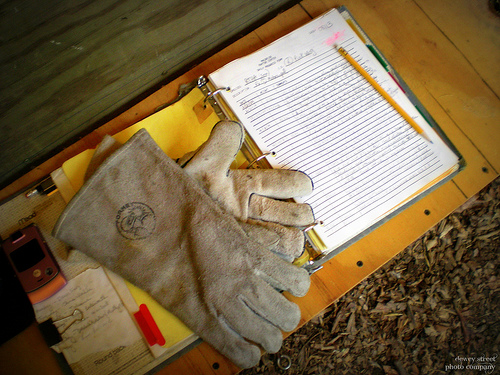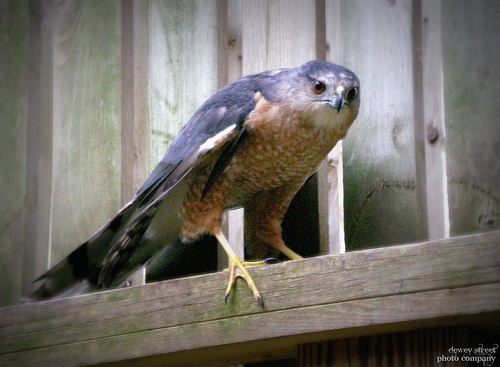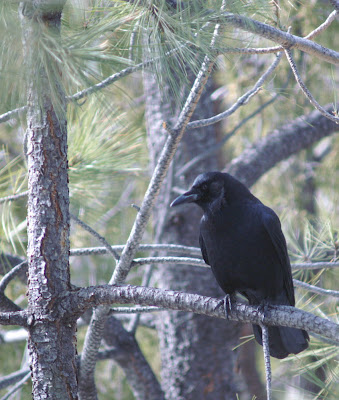 Hello all, NBB here. Sharon is safely in Germany just now, waiting to travel to Kazakhstan tomorrow.
Hello all, NBB here. Sharon is safely in Germany just now, waiting to travel to Kazakhstan tomorrow.
Today's entry is from Dawn Frary, Volunteer Owl Feeder and Wildlife Rehabilitator, Macbride Raptor Project. You can read more of her stuff at her wildlife rehabilitation blog: For the Birds.
Best. Rehab. Ever
Tonight was perhaps the best rehab session I’ve had so far in my volunteer-career as a wildlife rehabilitator. I hadn’t rehabbed in the two weeks prior to tonight, and it felt great to get back in the flight cage and see how my feathered friends are doing. Last Monday, I didn’t go out to the raptor center because I didn’t feel well and the week before I didn’t fly either bird because they both had additional injuries that were separate from their “regular” injuries (i.e. the injuries for which they are in the flight cage in the first place). I didn’t want to agitate anything further so I let them be. It looks like letting them rest was a good idea because they both were in fine form tonight.
 My rehab accountrements: leather falconer gloves, rehab notebook, trusty pencil.
My rehab accountrements: leather falconer gloves, rehab notebook, trusty pencil.
I began with the red tailed hawk, who I fully expected to be as much of a pain in the butt as he was last time I flew him. If you will recall, I spent nearly an hour chasing him along the floor of the flight cage to no avail at all - he barely flew for me, so I put him back without completing his regimen of five perch-to-perches. Tonight was completely different. After catching him (which was the hardest part of the whole ordeal), he proceeded to give me his five perch-to-perch (P-P) flights plus an additional two P-Ps. I felt like he and I were perfectly in sync and that he understood exactly what I wanted him to do. He didn’t struggle while being held, and he didn’t put up a fight once I had caught him and was holding him. His flying mechanics have improved greatly since the last time I worked with him, and he demonstrated a vast improvement in his landings. I tried to offer him positive feedback and cheer him on while he was going through his exercises, which in my mind makes all the difference. I completed his exercises in about 30 minutes, I think, and got him back in his cage safely and soundly.
The armpit biter great horned owl was up next. Once he came down from his high perch on the wall, I caught him easily only to be bitten very hard on the left arm. It left a tiny but very painful welt. But, since I’m used to the sharp sting of his beak at this point, I got right to his wing stretches and then launched him into the air from the middle of the flight cage. His flight had improved tremendously since our last session, as well. His height, speed, glides, and landings were all those of a bird who was well on his way to being released back into the wild. After being a resident of the MRP since early winter, I’m sure he is eager to get back to the woods and tell all his friends about the mean girl who made him fly back and forth inside a big cage.
The new kid: a Cooper's hawk was brought to the flight cage this week. He is under observation only for right now.
I was so thrilled after the rehab session that I literally jumped up and down afterward. I was happy with the birds’ performances, but was also happy with myself for being what I felt was a very observant and patient rehabber. I did not allow them to intimidate me, which I do sometimes because, well, they are large wild birds who are not happy about their current living situation and the fact that people in big leather gloves come into their space, corner them, grab them by the legs, and make them do flying exercises.
Sometimes it’s also easy to forget that there is a barrier between myself and these birds, and that barrier is called WILDNESS. These birds, no matter now much I talk to them or anthropomorphosize them, are wild animals. They want nothing to do with me. When I’m holding them and looking into their eyes (from a mere six inches away) thinking about how amazing it is to be thisclose to a wild great horned owl, they are thinking, “I’d kill you right now if I could.”
It doesn’t bother me. I signed up for this so I can’t complain about the bites or the birds’ blatant animosity toward my presence in their immediate space. I am helping them, whether they know it (or like it) or not. And tonight, I felt like the three of us - me, the hawk, and the owl - were all on the same page. We danced. I led.
They’ll thank me in the end.
I made two videos from today’s session, you can view them here and here.
Thanks, Dawn. Look for another entry tomorrow!























